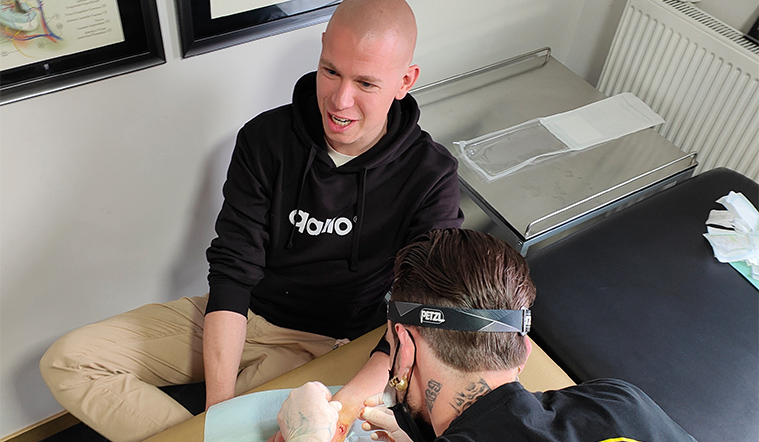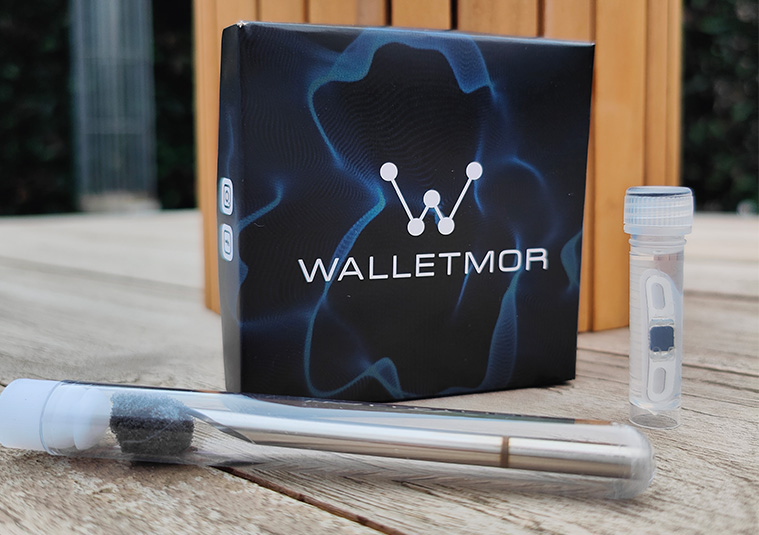[ad_1]
Lars Goossens is a 31-year-old video producer who works for a Belgian production house in Antwerp. During his free time, he loves going on road trips, attending music festivals and watching the perplexed expressions of onlookers as he pays at a card machine by placing his left hand on it. That last part is possible because Goossens’ left hand has a small device implant from a London-based company called Walletmor.
The tiny device is about the size of a safety pin, less than 0.5 mm thick. It consists of an integrated circuit and a metal sheath that acts as an antenna and comes enclosed in a hermetic bio-housing made out of a biopolymer. According to Walletmor, this biopolymer is completely safe since it is made out of a special kind of medical-grade material. Walletmor claims to be the first in the world to offer a wireless payment solution implanted in the human body.
“There are a lot of risks when you put something inside your body. Due to this, we run a variety of medical tests to ensure that it doesn’t cause any adverse reactions. The device and the materials it is made of have passed all medical procedures that test for inflammation, toxicity, etc. We even tested the device with heat to ensure that the device is fully biocompatible” Wojtek Paprota, founder and CEO of Walletmor told the indianexpress.com.
The implant can be inserted at one of the 100 Walletmor certified installation providers which include hospitals, clinics and body modification centres. These registered centres are present across the United Kingdom, the United States, and across Europe in countries like France, Germany, Spain, Portugal, Poland, Norway, etc.
 Goossens is pictured here getting his implant installed at a registered centre. (Image credit: Lars Goossens)
Goossens is pictured here getting his implant installed at a registered centre. (Image credit: Lars Goossens)
The Near Field Communication(NFC)-based implant is a completely passive device, requiring no power source. It emits no radio waves and is only activated when it comes close to a contactless payment terminal. Since it uses the widely adopted NFC standard, it can be used at any payment terminal which supports the ‘tap-to-pay’ option for credit and debit cards.
After it is implanted, the device can be paired with a digital wallet solution provider that will allow the user to maintain a wallet balance and control payments through the device. The implant itself is priced at 199 euros.

 The implant is pictured here in the vial on the right. (Image credit: Lars Goossens)
The implant is pictured here in the vial on the right. (Image credit: Lars Goossens)
Walletmor has partnered with different payment service providers, which include MuchBetter in the United Kingdom, iCard in the European Union and PureWrist in the United States. Walletmor customers can use the apps of these payment service providers to control the usage of their implant: recharge their wallet, create payment limits etc.
Goossens first came to know about this technology when a Walletmor representative reached out to his friend Kenneth, a tech journalist for a Belgian television channel. The two friends decided to get the implants together, though initially, his friend’s implant did not work. It appeared that one batch of devices had a soldering defect though the company did eventually replace this with a working option.
The implant initially took a bit of time to get used to since the antenna it had was not as strong as the ones found in payment cards. It took Goossens a bit of practice before he figured out how to place his hand on the payment terminal so that it got detected on the first try. He admits he gets funny reactions each time he uses the device at a terminal. “So now if I go to a store, I remove my Apple watch so that people know that is not how I am paying. I say ‘pay by card’ and then I use my hand on the terminal just to see people’s reaction,” he said.
But the in-person reactions that he receives are tame compared to the ones he got online. “We posted about this online and we got a lot of hate. We were called children of Satan, etc. People were saying that the government could use the chip to track us but that’s not true. They probably typed these comments on mobile phones which is even easier for governments to track,” he pointed out.
Still, the potential for misuse of this technology is not lost on Paprota, who has tried out various iterations of the device on himself. “The one thing I fear with this technology is that one day, governments of countries could make it obligatory for their citizens. If we are approached for such a project, we will say no. It might be great from a business perspective but we don’t want to be part of that. We want people to have the freedom to choose for themselves,” he stressed.
But he added that any concerns raised about the device can also be raised about credit cards that have the wireless tap feature. Also, the user has complete control over how the device is used and can place limits on payments that can be made with the device. They can also choose to temporarily deactivate it if needed.
But Paprota imagines many more applications for the device than just payments. “For example, if you ever need an ambulance, a registered paramedic could scan your hand for the chip and find out whether you have allergies and other information. We also imagine connecting it with Digital EU so that you have your identification details no matter where you go,” he explained.
And these applications are not that far away. In fact, Goossens is already relying on the implant to lock and unlock the doors at his home and studio.
!function(f,b,e,v,n,t,s)
{if(f.fbq)return;n=f.fbq=function(){n.callMethod?
n.callMethod.apply(n,arguments):n.queue.push(arguments)};
if(!f._fbq)f._fbq=n;n.push=n;n.loaded=!0;n.version=’2.0′;
n.queue=[];t=b.createElement(e);t.async=!0;
t.src=v;s=b.getElementsByTagName(e)[0];
s.parentNode.insertBefore(t,s)}(window, document,’script’,
‘https://connect.facebook.net/en_US/fbevents.js’);
fbq(‘init’, ‘444470064056909’);
fbq(‘track’, ‘PageView’);
[ad_2]
Source link


